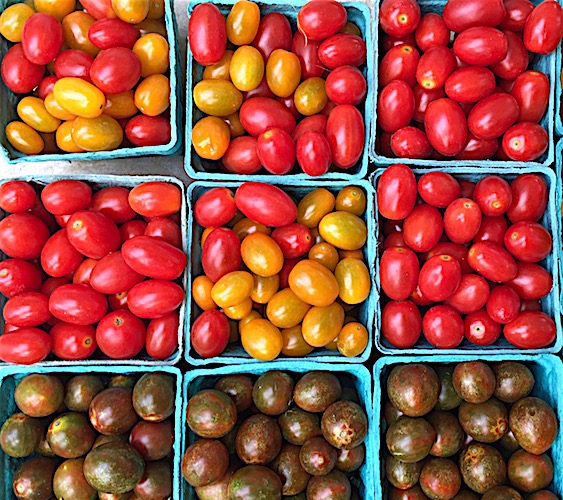
When you just don’t know what to make for dinner, head out to your local greenmarket. Farms are producing at their peak in much of the country right now and all that bounty is just waiting for you to bring it home.

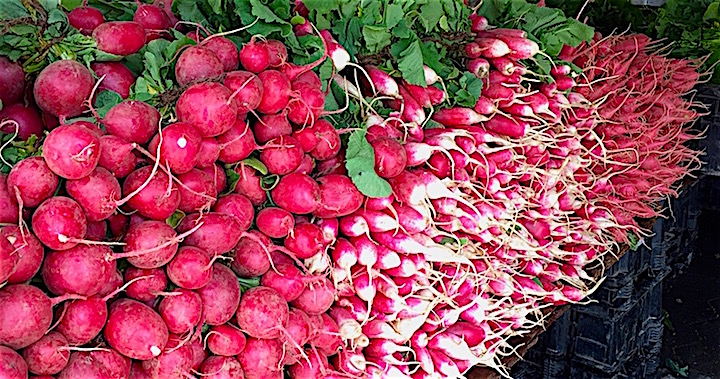
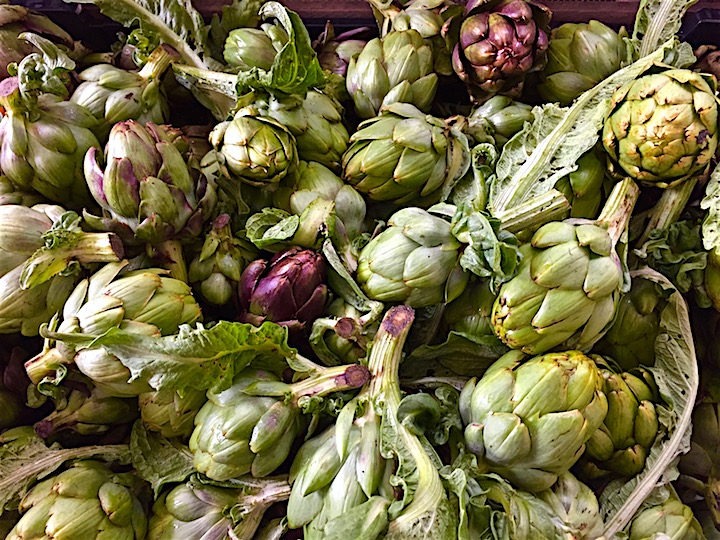
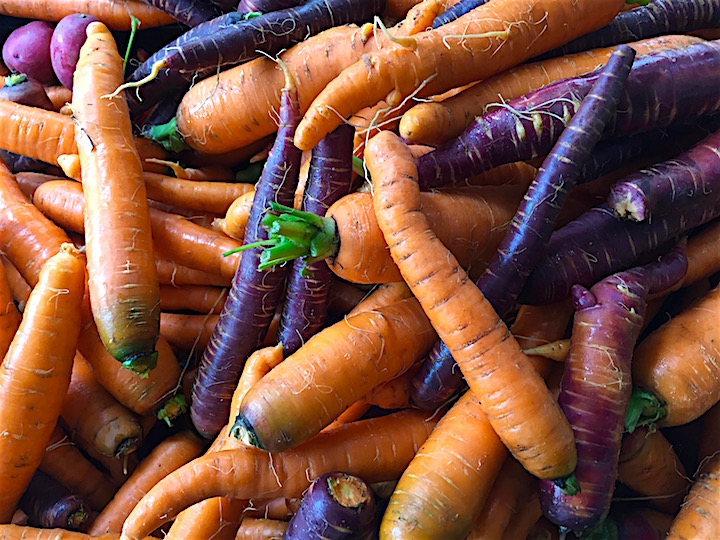
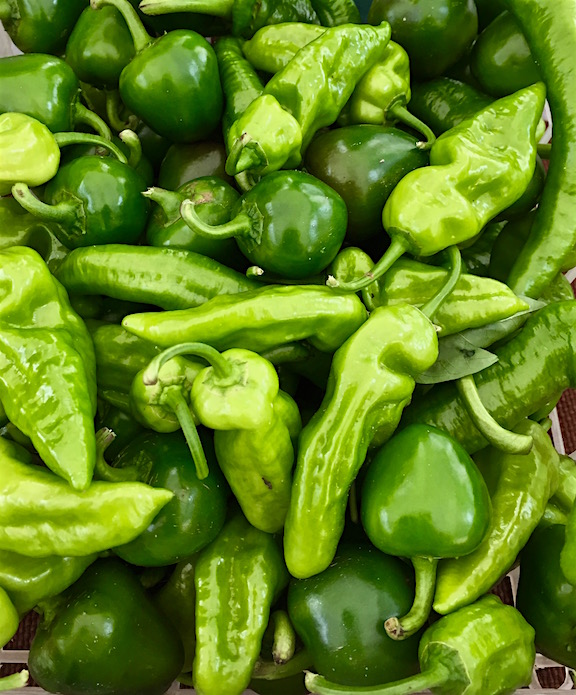
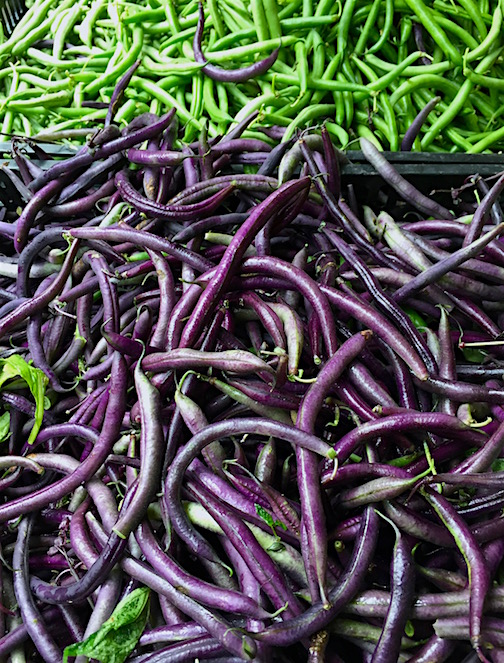
making food simpler

When you just don’t know what to make for dinner, head out to your local greenmarket. Farms are producing at their peak in much of the country right now and all that bounty is just waiting for you to bring it home.






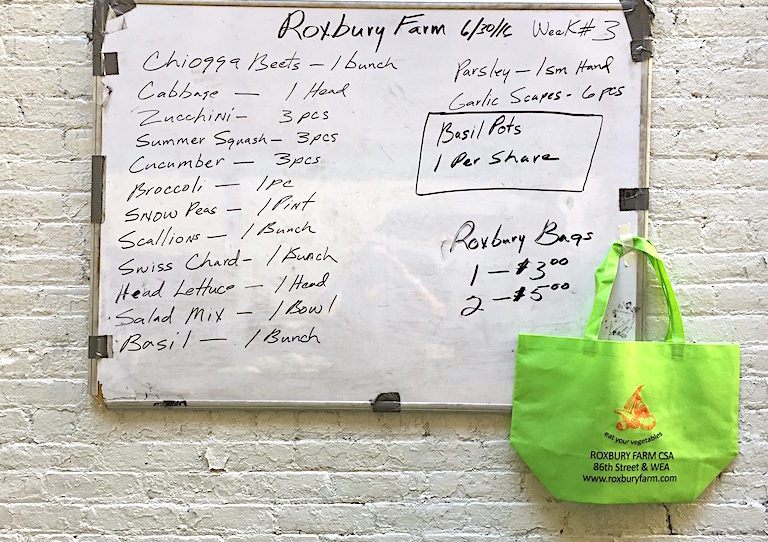
Community supported agriculture (CSA) is a partnership in which individual farms are supported by customers/members who pay up front for a season of vegetable deliveries. We have belonged to a CSA for 21 years, since our son was born. Our first farmers, Hugh and Hannah from Threshold Farm, stopped making city deliveries after 7 or 8 years to concentrate on their local community and their orchards (but we have followed their progress and family over the years and still buy delicious apples, dairy products and vinegar from them when in Columbia County). Our current CSA – Roxbury Farm, to which we have belonged for more than 10 years now, was one of the first to start coming to New York. We receive not only amazing vegetables every year, but also learn so much about farming and the farming life from their thoughtful and insightful weekly newsletters, including recipes for each week’s bounty.
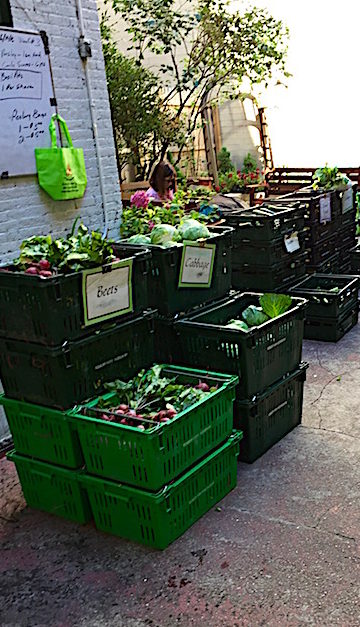
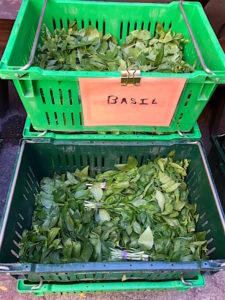 Our current farmers are not only organic but also biodynamic (as were the first), so they farm without pesticides. Their knowledge and practice provide us with a steady source of nutritious and tasty food, including their own lamb, pork and beef which can we order from their website. Every week we pick up whatever 8 – 12 vegetables they picked that that were ripe that week, except in the fall when there are squash, garlic, and onions, etc. that have been aged appropriately so we can store them. We get everything from sugar snap peas, scallions and asian greens like mizuna or tatsoi to basil, dill, cilantro and parsley to tomatoes, broccoli rabe, sweet corn and buttercup squash, to name just a few.
Our current farmers are not only organic but also biodynamic (as were the first), so they farm without pesticides. Their knowledge and practice provide us with a steady source of nutritious and tasty food, including their own lamb, pork and beef which can we order from their website. Every week we pick up whatever 8 – 12 vegetables they picked that that were ripe that week, except in the fall when there are squash, garlic, and onions, etc. that have been aged appropriately so we can store them. We get everything from sugar snap peas, scallions and asian greens like mizuna or tatsoi to basil, dill, cilantro and parsley to tomatoes, broccoli rabe, sweet corn and buttercup squash, to name just a few.
Since we get whatever they grow, I try things I might never have purchased because I wasn’t familiar with them or didn’t think I liked, such as beet greens, celeriac, and Swiss chard, all of which I now have learned to prepare and enjoy. Because their newsletters keep us informed of their weekly struggles (like equipment, insects and the effects of weather on crop outcomes), as well as interesting essays on farm life and work, our farmers have become the rock stars of our summers and autumns; They provide us not only with produce but also remind us of the hard work and commitment demanded in cultivating the land, growing, harvesting, and delivering those vegetables. We feel deep gratitude to Jody and Jean Paul, and their crew, as we collect our share each week and when we eat it.
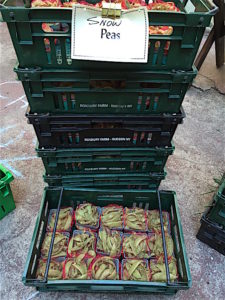 In recent years, we have subscribed to their winter box program, a 30 lb. box of winter storage vegetables that comes monthly December through February. That means we have local carrots, beets, cabbage, onions, sweet potatoes, celeriac, garlic, watermelon radishes, squash and potatoes for most of the winter. All I have to do is supplement with greens or frozen veggies until the spring crops appear at the farmers markets.
In recent years, we have subscribed to their winter box program, a 30 lb. box of winter storage vegetables that comes monthly December through February. That means we have local carrots, beets, cabbage, onions, sweet potatoes, celeriac, garlic, watermelon radishes, squash and potatoes for most of the winter. All I have to do is supplement with greens or frozen veggies until the spring crops appear at the farmers markets.
If you are interested in joining a CSA, check out the Just Food website – justfood.org/csaloc – for NYC. For locating a CSA in the tri-state area, localharvest.org is a useful site. Different states and areas of the country have their own websites. Just search CSA and the name of your state or part of the country. Or try https://pubs.nal.usda.gov/organizations-and-websites-related-community-supported-agriculture. It’s an easy way to support local farms, get fresh, local produce directly from the farmers and connect to a community of people who care about well grown food and the people who provide it.

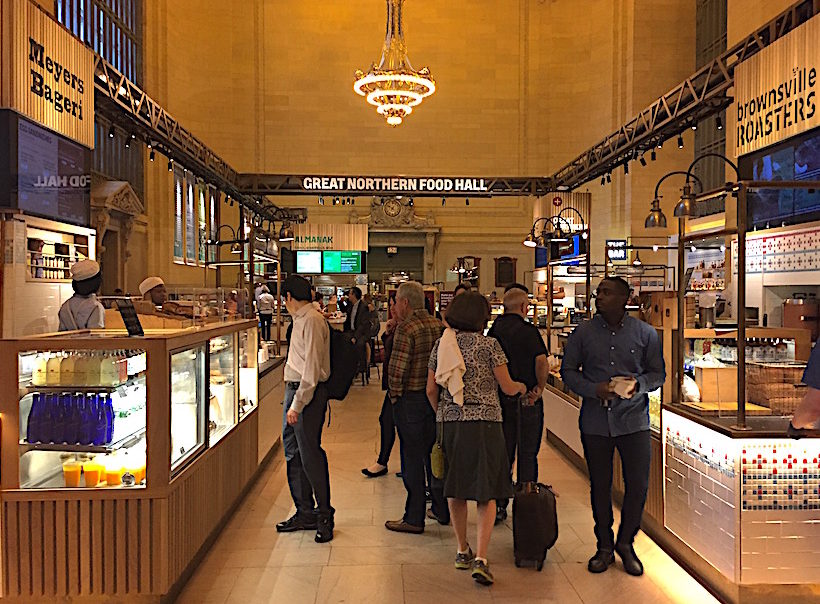
It used to be that if you were catching a train at Grand Central Station and needed something to eat, you could grab a bagel at Zaro’s, some nuts at Hudson News or hunker down for a meal at the Oyster Bar. In recent years, the lower level food court has been upgraded and improved but I wouldn’t eat there by choice. The high- end marketplace on the Lexington Avenue side of the station, anchored by Eli Zabar’s and including a nut shop, fish market, coffee shop, flowers, cheese and charcuterie is well stocked but it is quite pricey. I would buy bread or a gift there but nothing else really beckons to me.
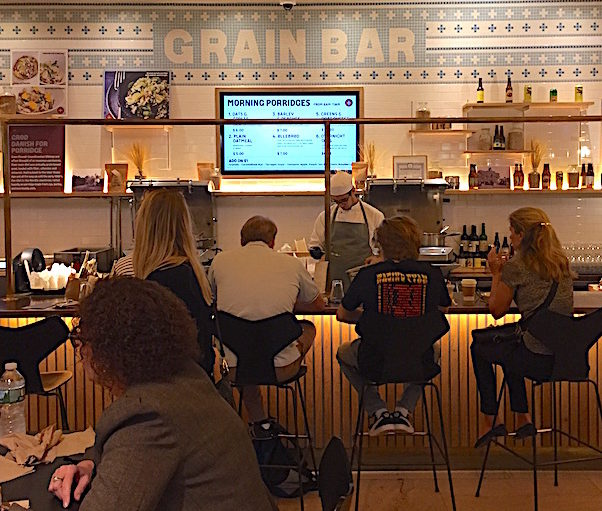
I’m happy to report there are new grab and go and dine-in options in Grand Central. Claus Meyer, the Danish restaurateur who opened a chain of bakeries and Noma (voted best restaurant for several years running) in Copenhagen, recently turned his culinary talents to bringing Scandinavian food to New York. Starting with a pop-up patisserie, now brick and mortar, and a coffee roaster in Brooklyn, he has now tackled Manhattan. Lucky for us, he opened the Great Nordic Food Hall this summer in half of Vanderbilt Hall, the old Grand Central waiting room on 42nd Street, a bakery and deli near the IRT subway, a “hot dog” (really sausage) kiosk, and Agern, a high end restaurant focusing on local and seasonal food and drink, which I haven’t tried yet but hope to find an occasion to do so.
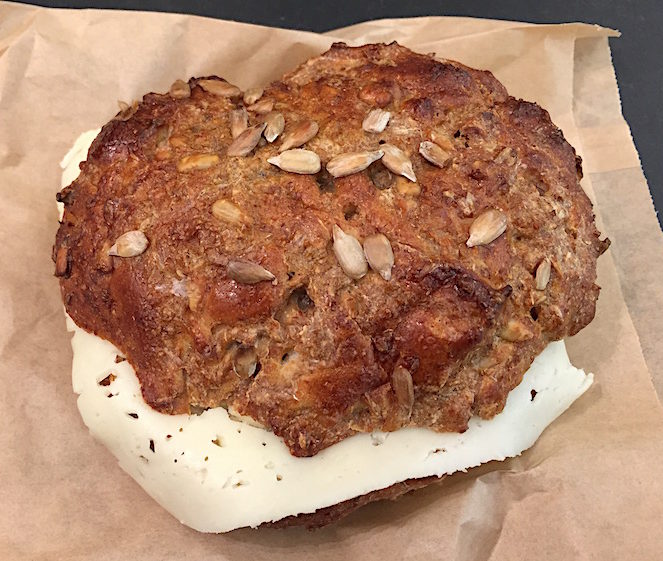
Since finding the Meyer Bageri (the bakery) at the Great Northern Deli, I have detoured whenever in the neighborhood or taking the train or the shuttle (just down the hall) to buy a sourdough or whole grain rye bread and, full disclosure, the raspberry bars – they are heavenly! Full of freshly made raspberry filling and sweet, buttery pastry, they are a reason to take the train. After sampling the delectable almond poppyseed twist and flaky, creamy maple pecan Danish, I didn’t dare try their gluten-free valrhona chocolate brownies but they look fantastic. The deli also sells sandwiches, drinks, bags of granola, cookbooks and gift items, in case you forgot a little something, either as a hostess gift or to eat while waiting for or riding a train.
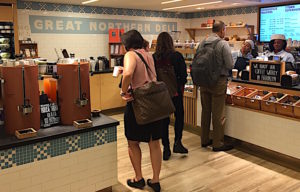

Next door to the deli is the diminutive but well designed and very tasty Danish Dogs. These are not traditional hot dogs but for $8 you have a choice of 4 kinds of sausage on an in-house made hot dog bun with abundant and interesting toppings including lingonberries, beet remoulade, cucumber salad, sorrel leaves and fried onions. Just remembering the delicious chicken sausage assemblage I ate there makes me want to return in a hurry! Until 10:30 every morning (when it is really too early to be seen eating a hot dog), this counter serves made to order $7 omelet sandwiches.
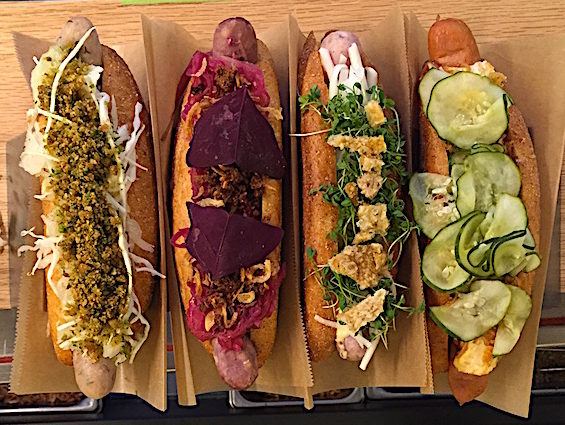
The food hall is appealingly spare, in neutral tones with a calm vibe (remarkable considering its setting) and includes a bar, coffee counter and kiosks for sandwiches (both open face Danish style smorrebrod and regular) and baked goods. There are plenty of tables for eating what you purchase as well as a sit-down, full service cafe for salads and hot food. Over the summer, my husband and I tried several sandwiches, drinks and desserts – all were excellent, including the coffee (from Meyer’s Brownsville Roasters.) Our favorite was the celeriac sandwich (thinly sliced celery root, green apple and walnut ($10) on a flavorful in-house made whole grain “hoagie” and the above mentioned hindbaersnitte, the raspberry bar so good my mouth waters just thinking about it.
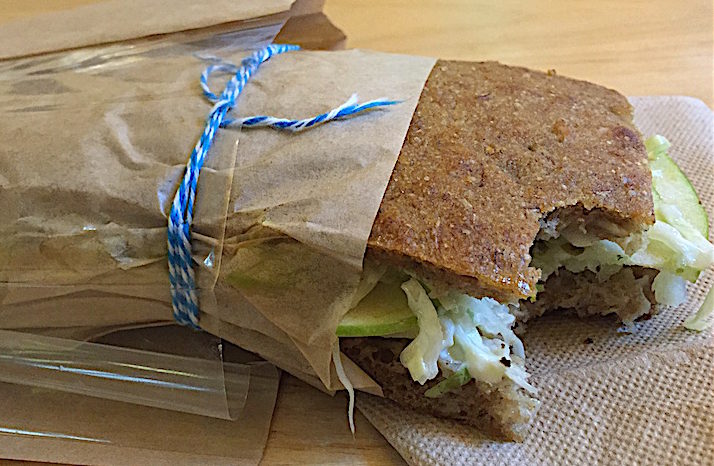
The philosophy behind the food hall is as attractive as the food displays. The lowest paid employees start at the living wage of $15/hour with benefits – what other casual dining arena in New York can say that? Food is actually locally sourced and well raised, there is a feeling of quality over quantity, and although it is busy, the food hall is a pleasant place to sit and have a coffee, lunch or drink at the bar. It is not that the food is less expensive than what I could find in the downstairs food court. It’s just that it is so much more appealing on so many levels. Instead of just grabbing the least “bad” thing I could find while running for a train, the Nordic Food Hall is a place at which I will plan to eat often and intentionally.
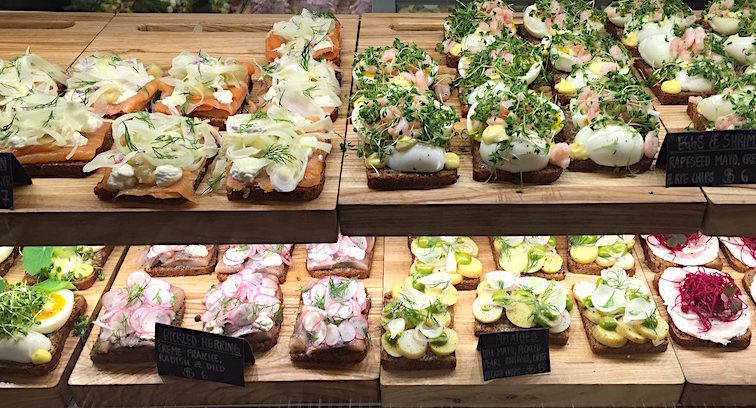

Now that the dog days of summer are behind us, we have a couple of months of gorgeous days stretching out ahead of us. When nights get cooler and days get shorter, all kinds of cooking are once more possible. As I put away my shorts and t-shirts and pull out long pants and cardigans, I will shift from light salad dinners to more substantial soups, grains and proteins.
Eating local food has become much easier with the growth of CSA’s and farm markets. And food stores are listening to customers who want to buy local. From neighborhood grocers (in our case, 2 delightful brothers – Taki and Taso -who are always accommodating to their customers and stock all sorts of interesting gourmet items and fresh produce) to giant Whole Foods, grocery stores are stocking more regionally grown fruits and vegetables. (By the way, the Whole Foods app offers discounts otherwise not available).
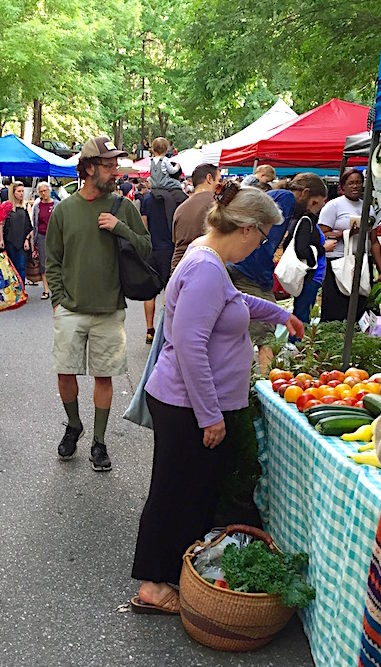
Learning to eat seasonally means trying to eat according to what the local farms are delivering. In New York, as well as most cities at this point, it is possible to eat almost anything at any time of year. We don’t even look twice at cantaloupe in January or sugar snap peas in November or think about the fact that they may have been shipped from 5,000 miles away. This cannot be good for our climate or energy problems nor is it as nutritious to eat food that has been sprayed with chemicals or wax so it remains fresh looking after transit.
Over many years of belonging to a CSA and shopping the farmer’s markets, I have become more aware of the rhythm of cooking with the seasons. I make lots of lighter green salads, string beans, tomatoes, and cucumbers during the summer, more squashes, cauliflower, potatoes, and kale in the fall, and peas, fiddleheads, ramps, and asparagus in the spring while during the winter I rely more on storage vegetables such as beets, sweet potatoes, cabbage, parsnips, beets, and carrots. Of course, I supplement with frozen and sometimes buy non-local greens to satisfy a craving. Nowhere near me is coffee local (even if locally roasted) nor are spices, citrus fruit, most grains, avocados or olive oil but I use them anyway. More and more, however, I try to pay attention to the local growing season, especially for fruits and vegetables. This also makes it easier to decide what to cook and provides variety in our diet. Whereas I would never dream of cooking a bean soup with root veggies in the summer, it is the perfect meal for a cold winter day. And while a salad of baby lettuces would leave me chilly in January, it might help me feel cooler in the heat of July.
I can heartily recommend a book that helped me make the transition. Animal, Vegetable, Miracle by Barbara Kingsolver (with her daughter and husband) is the most inspirational story I can think of that describes learning to eat local and, therefore, seasonally. She and her family decided to eat only foods grown or farmed within their region (in Virginia) with only a few exceptions. It’s an engaging, fun read and explains how they learned and managed.

Eating this way can be challenging, especially in winter. But here, too, a little planning goes a long way. If I made and froze pesto during the summer when basil and parsley were abundant (and garlic scapes in the spring), I will have a fresh tasting local source of greens with pasta, potatoes, fish, or chicken, even toast, through the winter months. There is still some fresh basil around in the markets here, as well as arugula, cilantro and kale, all of which make tasty pesto to freeze without cheese, which you can add later, if you wish. Pickles, dilly beans, and sauerkraut taste pretty refreshing on a cold night when nothing else green is available. There is still time to make a batch of dried or stewed tomatoes or tomato sauce to put up or pickle cucumbers, radishes or jalapeños for a mid-February treat. The Google machine is chock full of recipes and techniques. And don’t forget there are some greenhouse vegetables, like watercress, that are grown year round and can add some fresh green whenever needed.
I don’t have enough space in my little apartment freezer compartment to freeze my own vegetables but I am a big fan of and stock frozen peas, brussel sprouts, and corn for side dishes and pastas and frozen spinach and kale for spanakopita and lasagna. Cabbage, carrot or beet salads are delicious without any lettuce in sight and those storage vegetables last well even until spring. (Squashes make gorgeous arrangements on a counter or table while most of the others like onions and the root vegetables need either a dark or cold place). Now is the moment when I wish I had a dehydrator for all kinds of fruits and vegetables. Dried tomatoes, apricots, herbs, onions and peppers can enliven a winter meal. Hang up a bunch of dill, thyme and rosemary now and they will reward you in a couple of months. If you keep any of these items in your kitchen, winter becomes a lot tastier.
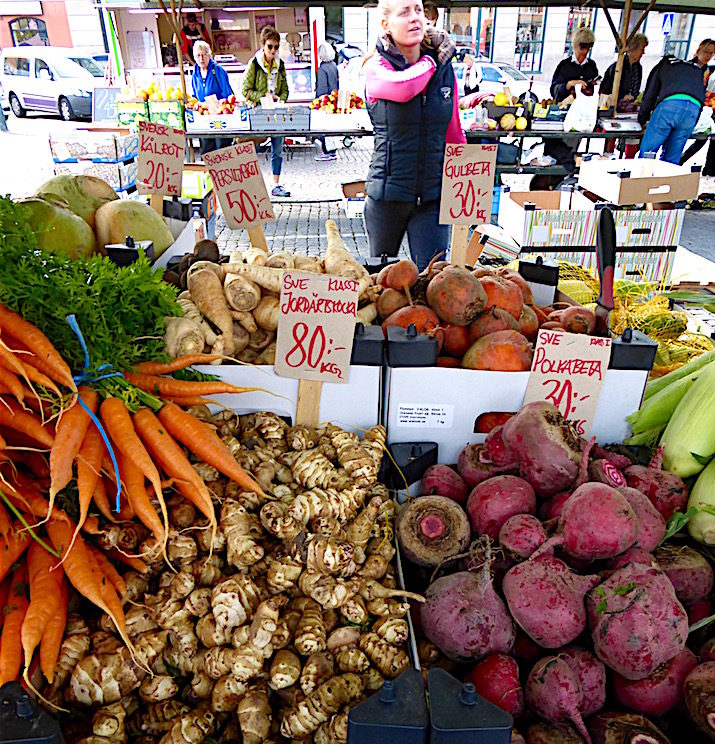
Now that autumn is upon us, I will restock my supply of lentils, rice, millet, quinoa, amaranth, oats, garbanzos and miso so when I want to make soup, rice and beans, paella or grain patties, I will be ready. These aren’t local but I will cook them with local vegetables. I will be cooking with well raised lamb, pork, eggs and beef as well as wild fish and shellfish now that the days are cooler but in smaller quantities than the pulses and grains. Frittatas, quiches and heartier salads with fennel and celery root will soon be on my table. When I’m out of ideas, I will walk through the farmer’s market to get inspiration. What will you make this fall?